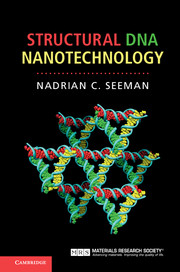Book contents
- Frontmatter
- Contents
- Preface
- 1 The origin of structural DNA nanotechnology
- 2 The design of DNA sequences for branched systems
- 3 Motif design based on reciprocal exchange
- 4 Single-stranded DNA topology and motif design
- 5 Experimental techniques
- 6 A short historical interlude: the search for robust DNA motifs
- 7 Combining DNA motifs into larger multi-component constructs
- 8 DNA nanomechanical devices
- 9 DNA origami and DNA bricks
- 10 Combining structure and motion
- 11 Self-replicating systems
- 12 Computing with DNA
- 13 Not just plain vanilla DNA nanotechnology: other pairings, other backbones
- 14 DNA nanotechnology organizing other materials
- Afterword
- Index
- References
8 - DNA nanomechanical devices
Published online by Cambridge University Press: 05 December 2015
- Frontmatter
- Contents
- Preface
- 1 The origin of structural DNA nanotechnology
- 2 The design of DNA sequences for branched systems
- 3 Motif design based on reciprocal exchange
- 4 Single-stranded DNA topology and motif design
- 5 Experimental techniques
- 6 A short historical interlude: the search for robust DNA motifs
- 7 Combining DNA motifs into larger multi-component constructs
- 8 DNA nanomechanical devices
- 9 DNA origami and DNA bricks
- 10 Combining structure and motion
- 11 Self-replicating systems
- 12 Computing with DNA
- 13 Not just plain vanilla DNA nanotechnology: other pairings, other backbones
- 14 DNA nanotechnology organizing other materials
- Afterword
- Index
- References
Summary
We have been talking so far about static DNA structures: we make them with some expectation of their 3D geometry, or perhaps of their topology, and then they sit there, perhaps changing shape as a result of thermal fluctuations. However, it is certainly possible to do more with DNA than just make static species. It is also possible to make molecules that can change their shapes, producing multi-state devices that can produce mechanical action on the nanoscale. The key DNA devices operate on two different principles: either DNA structural transitions, or programmed sequence-dependent devices whose states can be addressed or created individually. DNA structural transitions can be based on the contents of the solution, but they are only individually addressable by nuanced chemistry, such as the formation of the various knots shown in Figure 4-4, or by the action of protein molecules.
Robust devices. As all of you reading this book are aware, things can happen in chemical systems that do not happen on the macroscopic scale. If we are making a DNA-based nanomechanical device, we term it a “robust” device if all of the molecules undergo the same transition, looking the same after the transition as they did before. If the strands of its framework can recombine and perhaps form another species (a dimer or a breakdown product), then we would say that the device is not robust. Exchange of strands while in an intermediate state is another example of non-robust behavior. Sometimes the conditions will define the robustness of the device. If the device is based on a DNA structural transition, a partial transition of the ensemble of molecules will be the result if the transition trigger is not present in an overwhelming quantity; such conditions could be corrected, if necessary. The basic notion of a robust device is that it behaves like a macroscopic device made of simple machines: a lever is either up or down, a torsional element is either rotated or not, a movement occurs or it doesn't, throughout the ensemble of molecules in the system.
Shape-shifters
A key category of devices can be thought of as shape-shifters, molecules that have different structures under different conditions. Clearly a molecule at equilibrium will have a fixed shape or ensemble of shapes, and they won't change.
- Type
- Chapter
- Information
- Structural DNA Nanotechnology , pp. 130 - 149Publisher: Cambridge University PressPrint publication year: 2016



